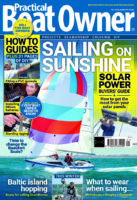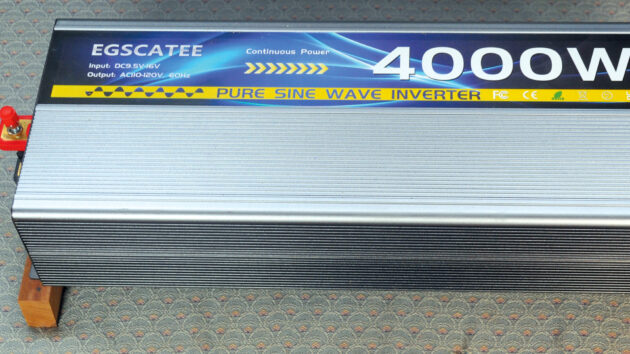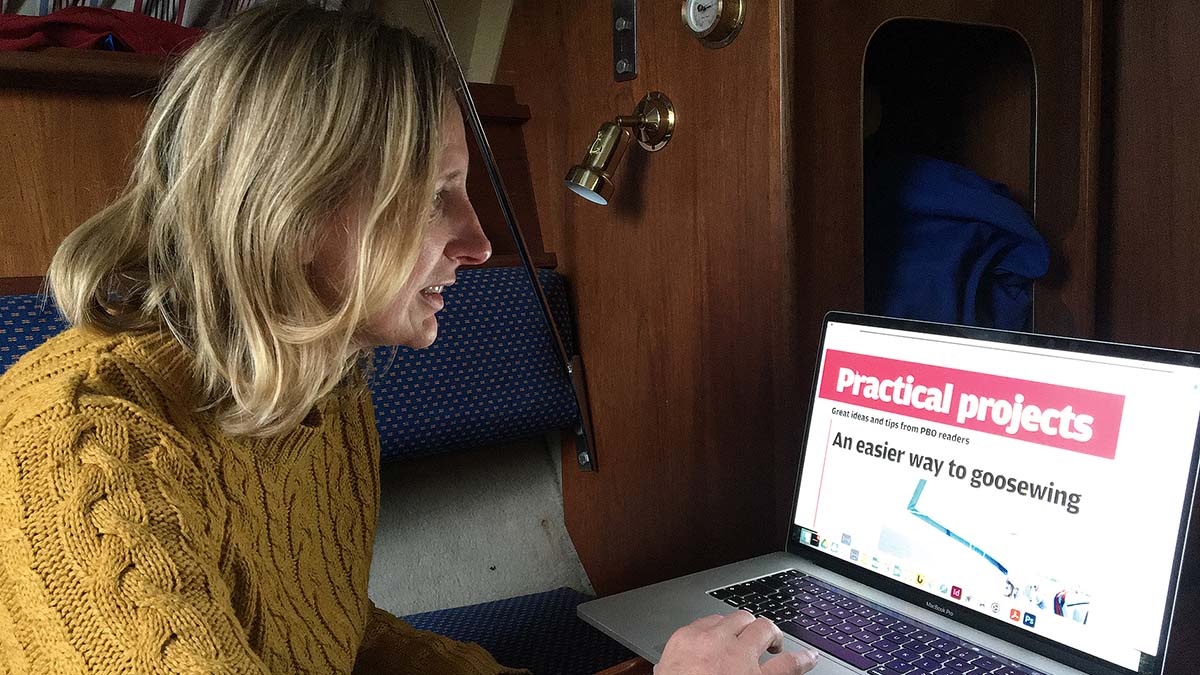Roger Hughes explains how he installed a boat inverter to have a powerful new source of silent AC power for his yacht.
When I bought my schooner Britannia, it only had a small 1,500W inverter that was not powerful enough to run the additional electrical devices I fitted as I modernised the 1977 yacht. She’s American-built, so the AC electrics are all 120V, but the principle of any boat inverter are exactly the same for any output voltage.
How does an inverter work?
Simply put, a boat inverter works the opposite way to a transformer; they take 12V current from the batteries and miraculously convert it to run the AC devices on your boat (120V or 240V).
Even small boats with hardly any electronics can benefit from an inverter, provided they have adequate batteries, because it offers an easy way to be able to operate equipment like a laptop or to recharge a phone.
Small camper vans nearly always have inverters to run their appliances when on the road, especially if there’s not room for a built-in generator. I even have a small portable inverter in my car to charge our phones and laptops while driving.
Britannia does have a big 6,500W diesel generator, so why did I want an inverter at all when, with the flick of a switch, we could have oodles of electricity to power the whole ship, without even blinking?
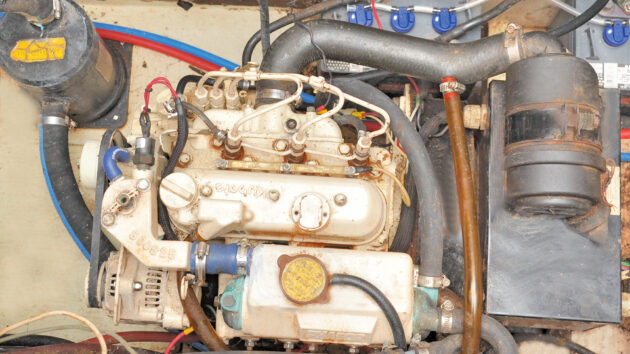
ABOVE With many different makes available, it can be a challenge to find the best inverter for a particular application. Roger’s choice was based on price, output, and specification. Photo: Roger Hughes.
The reason is simple – silence.
Even though it is well insulated under the cabin sole, we hated to run the generator for long periods, especially at night, because of the noise and possible annoyance to others anchored nearby. It was always nicer when we switched it off, but then there was no AC power anywhere, so this is where a good inverter comes in, to silently run all the appliances.
The power needed to run electrical devices is expressed in Watts (W) and usually printed on the actual device label. The term was named after James Watt (1736-1819), a Scottish engineer. Watts is the amount of power needed to run a device, and the result of current multiplied by voltage.
Current is the rate at which the energy flows down a wire, measured in amps (A). Volts (V) is the number of electrons between any two points in an electrical circuit. One watt is therefore equal to one volt multiplied by one amp: W = VxA.
Personally, I’ve always regarded these in comparative terms, knowing that something rated at 1,000W needs – or rather consumes – 10 times more power than something rated at 100W, and most people know that a 60W light bulb is brighter, and uses more electricity, than a 40W bulb.
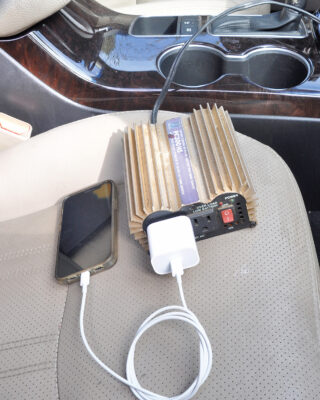
A small, portable inverter is very useful anywhere there is a 12V battery. This one is used in a car to charge a phone. Photo: Roger Hughes.
Power draw
During the modernisation of Britannia I fitted quite a few 120V appliances, like two 16,000Btu, (British thermal units), air conditioners of 1,560W each, a washer/dryer 1,800W, twin water heater elements 1,500W each, a convection microwave 1,225W, an electric toaster 1,200W, an electric kettle and a coffee maker 1,500W each. In addition, there were AC lights in three cabins, two heads, the galley and the saloon.
The boat inverter was also connected to the many outlet plugs in every area of the boat to be used for all kinds of personal devices that we take for granted when in a house.
Using this lot all at once would require towing a power station, but of course, they’re never all used at the same time when at sea.
If we ever need to use some of the larger consumer equipment simultaneously, like the washer/dryer and the air conditioners, I just switch the ‘genny’ on, which will practically run everything at once.
Britannia is a true liveaboard vessel with all the mod-cons of a small flat.
Due to the number of AC electrical devices now fitted, I decided to invest in a big inverter, and there certainly are a lot to choose from on the web. After comparing specifications and prices, I decided to buy an Egscatee 4,000W unit that I bought in a sale for £350.
This model is what is called a pure sine wave inverter that develops the same electricity as that used in a home, and is also best for a boat, allowing all AC devices, especially domestic appliances, to work at their maximum.
Of course, it is possible to find inverters of greater power and internal quality, and price, than the one I bought, but I only needed one as a supplementary power source when at sea. This boat inverter has a remote start/stop and a display that shows the input and output voltages and the battery condition.
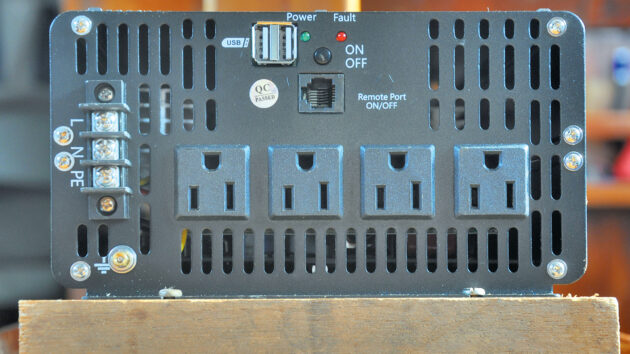
This shows the 120V AC outlet end of the inverter. Four individual plugs, one hot-wired terminal, USB plugs and a stop/start button that is overridden by the remote stop/start control. Photo: Roger Hughes.
My reasoning for buying a 4,000W output was that, in practice, inverters rarely actually generate their advertised wattage.
So if I wanted to draw, say, 3,000W, I needed one rated about 25% higher; this turned out to be a pretty accurate rule of thumb. There is also the consideration of start-up surge voltage, needed to kick-start many electrical devices that have a higher initial start-up than the advertised working wattage.
The Egscatee inverter also has four plugs in the back, so I plugged in four of the more frequently used appliances directly into these receptacles, bypassing the switches and heavy-duty wiring.
It also has two USB terminals that I extended to a twin USB terminal near the chart table, so we can just plug in our laptops and phones.
I added up my total 12V battery capacity at around 2,000Wh. This comes from eight 6V golf-cart batteries connected to make four 12V banks. There are also two large 12V batteries for engine starting and windlass operation.
All these can be interconnected or disconnected through two heavy-duty switches that allow great flexibility to switch batteries in or out of the system.
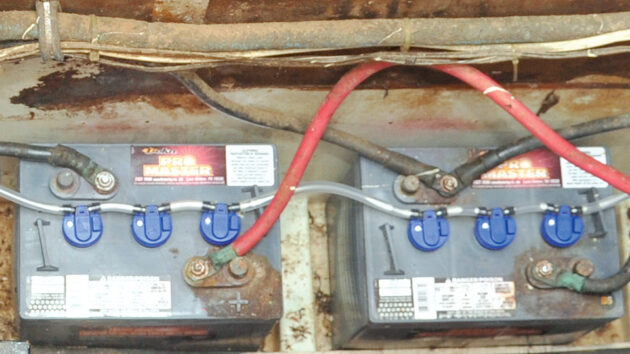
Britannia has a large battery bank consisting of two rows of deep-cycle golf cart batteries and two large 12V batteries for the engine start and windlass operation. photo: Roger Hughes.
Installing the boat inverter
I guessed that my inverter had arrived when I saw the delivery driver trundling an obviously heavy box down our driveway on a trolley. I found out just how heavy when I tried to lift it – it weighed 75lb (34kg)!
The first decision to be made was where to install this beast. The instructions said it should be used in a dry, well-ventilated space, but otherwise, the small four-page leaflet leaves a lot to be desired about installation, nor is it written in very good English.
To start with, there’s no such place as a dry, well-ventilated space in the bowels of a 40-year-old yacht, but I did have a large unused compartment that once housed a big battery.
During my search for a boat inverter, I read that it was best to install these things flat, ie on their bases, not sideways like they are often shown and like my old inverter was mounted in the engine room.
To help with the ventilation requirement, I mounted it on two 1½in wood blocks to allow air circulation all around and underneath. This done, I screwed it down into its new home, leaving plenty of room at either end for the input cables from the battery switches, and at the other end the power outlets.
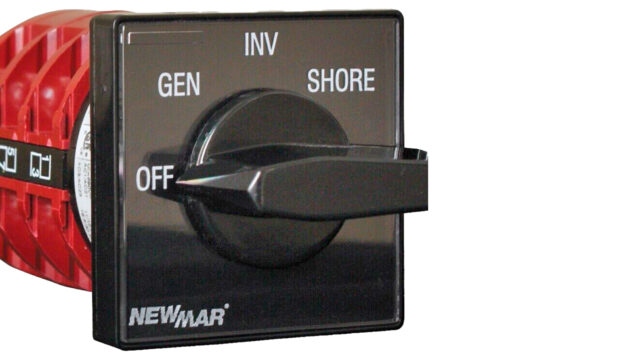
A transfer switch only allows one supply source at a time to come into the boat’s 120V AC system, whether it be from shore power, generator, or inverter.
The instruction manual also fails to address another important question: the thickness of the 12V input wires from the batteries. I knew these needed to be extra thick to carry the possible high draw from the batteries.
After discussing this with the inverter makers, and knowing the length of wire I needed, they advised 4AWG (American wire gauge), which is almost ¾in in diameter – a really thick, heavy wire like those used to start big diesel engines. This ran from the battery change-over switches to the inverter’s positive terminal and the return to the boat’s negative busbar.
When introducing more than one source of AC power into the boat’s system (one source being shore power in a marina and another from a generator), it is very important to isolate the sources to prevent any two AC sources from colliding. I was introducing a third source from the inverter, so I bought a four-way switch to replace the existing shore and ship AC inputs switch.
It was from NewMar electrics and cost a whopping £160! But it is certainly substantial. It is marked OFF, GENerator, INVerter, SHOREpower and ensures that only one AC power source can be introduced into the boat’s AC power system at any one time.
The input wires come in from the various AC sources, and the output wire from this switch goes to my two AC distribution panels and from there through appropriate contact breakers to all the boat’s appliances.
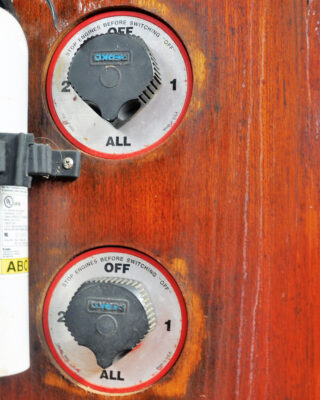
These heavy-duty change-over switches give great flexibility to be able to isolate Britannia’s port and starboard house banks. Even if the inverter depletes one side, the other can still work the important machinery like engine start, generator or windlass. Photo: Roger Hughes.
To complete the installation, I sealed off the compartment from the rest of the machinery space with a ¾in-thick plywood panel to help insulate the inverter from the engine bay heat. I also added a small 12V fan that comes on whenever the inverter is used and vents any hot air out of the compartment. After completing the wiring, all that remained was for me to cross my fingers and turn the master switch to INVerter.
I then gingerly pressed the inverter display start/stop button, and bingo – the display showed 13.3V input battery voltage and an output of 120V AC. It also showed a battery condition of about three-quarters charged.
I first switched on the 14 120V lights throughout the boat, and they responded with the same brightness as if they were connected to shore power. Next, I carefully tested each major appliance separately, and they all came to life without a single murmur from my mighty new power source. At anchor, it certainly is nice to boil the kettle for a cup of tea or the coffee-maker in the morning without having to start the generator, and to switch any of the AC lights on, which are brighter than the 12V lights.
Power out requires power in
Of course, you must never lose sight of the fact that all this power is coming from batteries that have been charged previously from another source, be it the engine alternator, the generator, or from shore power via the battery charger, and that all the power is merely being stored in the batteries.
When a boat inverter is being used on a yacht under sail with the engine switched off, nothing is being put back into the batteries, so even with a large battery capacity like Britannia’s, it is easy to run the batteries down inadvertently. It’s therefore important to make sure the engine start-battery is out of the loop when the inverter is on, and we always keep a watchful eye on the inverter display.
I suppose I now need to look at solar panels to keep the batteries charged up when sailing. So what I really need to tow behind Britannia is not a power station, but my bank manager…
Roger Hughes is an ex-pat English writer based in North Carolina, who has lived and sailed in the USA for the past 40 years. He is close to completing the full restoration and modification of his 51ft schooner, Britannia.
Boat battery care: the do’s and the don’ts
Stuart James of Predator Batteries shares his expert tips for achieving optimum battery performance on board your boat
What battery capacity? Working out your boat’s power requirements
In order to work out your boat’s battery capacity you need to know how much power you’re going to draw,…
Battery maintenance for boat owners: How to look after your boat batteries
For all but the smallest and simplest of craft a reliable supply of battery power is essential to keep both…
Which battery is best for my boat? How to increase battery capacity on board
With more and more electrical gear going on board the modern cruising yacht there comes a time when the battery…
Want to read more articles like this?

A subscription to Practical Boat Owner magazine costs around 40% less than the cover price.
Print and digital editions are available through Magazines Direct – where you can also find the latest deals.
PBO is packed with information to help you get the most from boat ownership – whether sail or power.
-
-
-
- Take your DIY skills to the next level with trusted advice on boat maintenance and repairs
- Impartial, in-depth gear reviews
- Practical cruising tips for making the most of your time afloat
-
-
Follow us on Facebook, Instagram, TikTok and Twitter

